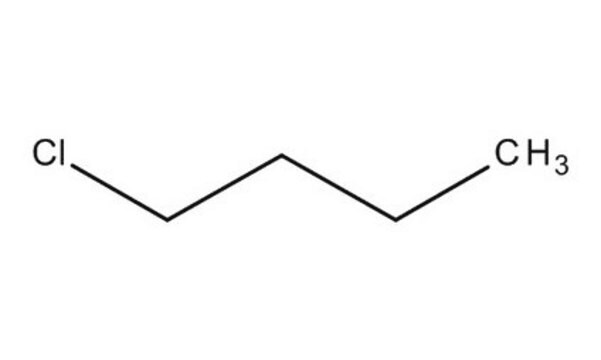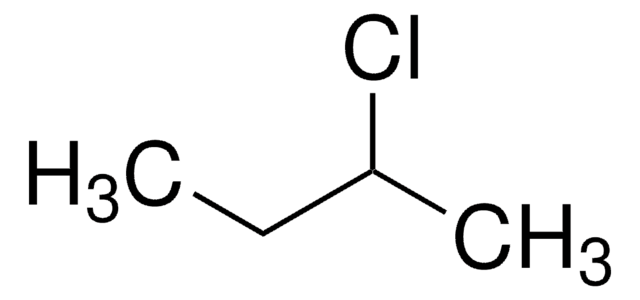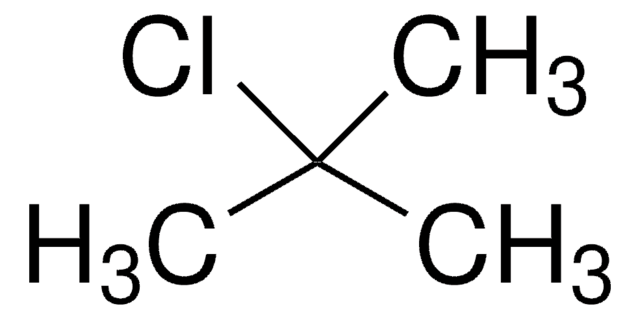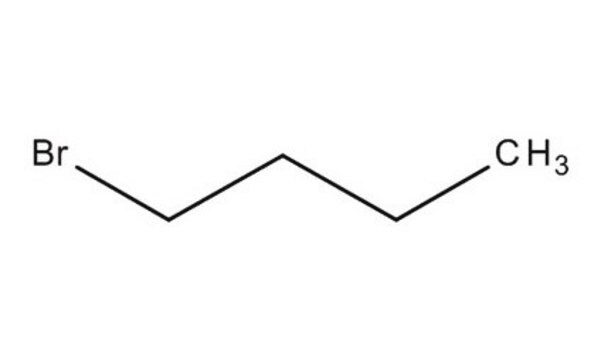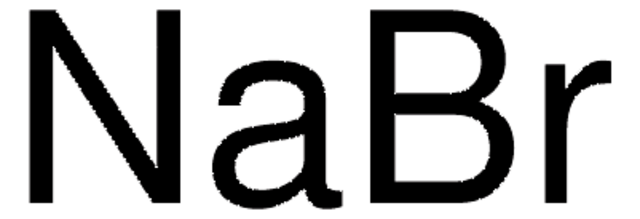1.01692
1-Chlorobutane
for liquid chromatography LiChrosolv®
Synonym(s):
1-Chlorobutane, n-Butyl chloride
About This Item
Recommended Products
vapor pressure
110 hPa ( 20 °C)
Quality Level
product line
LiChrosolv®
grade
isocratic
Assay
≥99.8% (GC)
form
liquid
autoignition temp.
280 °C
potency
2200 mg/kg LD50, oral (Rat)
expl. lim.
1.8-10.1 % (v/v)
technique(s)
HPLC: suitable
impurities
≤0.0002 meq/g Acidity
≤0.0002 meq/g Alkalinity
≤0.01% Water
evapn. residue
≤2.0 mg/L
transmittance
227 nm, ≥60%
232 nm, ≥80%
250 nm, ≥98%
bp
79 °C/1013 hPa
mp
-123 °C
transition temp
flash point -17 °C
density
0.886 g/cm3 at 20 °C
storage temp.
2-30°C
InChI
1S/C4H9Cl/c1-2-3-4-5/h2-4H2,1H3
InChI key
VFWCMGCRMGJXDK-UHFFFAOYSA-N
General description
Application
- Cl atoms-initiated degradation of 1-Chlorobutane and 2-Chlorobutane: This study investigates the kinetics and product analysis of the degradation of 1-Chlorobutane initiated by chlorine atoms. It provides insights into the atmospheric implications of halogenated hydrocarbons, relevant for environmental monitoring and analysis (Kar & Rajakumar, 2023).
- Efficient Remediation of p-chloroaniline Contaminated Soil: Utilizing activated persulfate in the presence of nanosized zero-valent iron/biochar composites, this study demonstrates a method that might be adaptable for the remediation of environments contaminated with similar compounds like 1-Chlorobutane. This is particularly valuable for environmental scientists and lab technicians working on soil decontamination (Guo et al., 2023).
- Rate Coefficient and Mechanism of the OH-Initiated Degradation of 1-Chlorobutane: Focusing on the atmospheric degradation of 1-Chlorobutane by hydroxyl radicals, this research provides critical data for understanding the environmental impact and the chemical behavior of 1-Chlorobutane in the atmosphere, important for researchers in environmental science and atmospheric chemistry (Jara-Toro et al., 2020).
- Genetic programming of catalytic Pseudomonas putida biofilms for boosting biodegradation of haloalkanes: This research demonstrates the genetic modification of bacteria to enhance their ability to degrade haloalkanes, including 1-Chlorobutane. This could interest principle investigators in biotech and pharma researching new methods of biodegradation for industrial applications (Benedetti et al., 2016).
Preparation Note
Analysis Note
Identity (IR): conforms
Evaporation residue: ≤ 2.0 mg/l
Water: ≤ 0.01 %
Acidity: ≤ 0.0002 meq/g
Alkalinity: ≤ 0.0002 meq/g
Transmission (at 227 nm): ≥ 60 %
Transmission (at 232 nm): ≥ 80 %
Transmission (from 250 nm): ≥ 98 %
Filtered by 0.2 µm filter
Other Notes
Legal Information
Not finding the right product?
Try our Product Selector Tool.
Signal Word
Danger
Hazard Statements
Precautionary Statements
Hazard Classifications
Aquatic Chronic 3 - Asp. Tox. 1 - Flam. Liq. 2
Storage Class Code
3 - Flammable liquids
WGK
WGK 2
Flash Point(F)
10.4 °F - closed cup
Flash Point(C)
-12 °C - closed cup
Regulatory Listings
Regulatory Listings are mainly provided for chemical products. Only limited information can be provided here for non-chemical products. No entry means none of the components are listed. It is the user’s obligation to ensure the safe and legal use of the product.
FSL
Group 4: Flammable liquids
Type 1 petroleums
Hazardous rank II
Water insoluble liquid
ISHL Indicated Name
Substances Subject to be Indicated Names
ISHL Notified Names
Substances Subject to be Notified Names
JAN Code
1.01692-901:
1016921000:
1016920000:
Certificates of Analysis (COA)
Search for Certificates of Analysis (COA) by entering the products Lot/Batch Number. Lot and Batch Numbers can be found on a product’s label following the words ‘Lot’ or ‘Batch’.
Already Own This Product?
Find documentation for the products that you have recently purchased in the Document Library.
Customers Also Viewed
Our team of scientists has experience in all areas of research including Life Science, Material Science, Chemical Synthesis, Chromatography, Analytical and many others.
Contact Technical Service